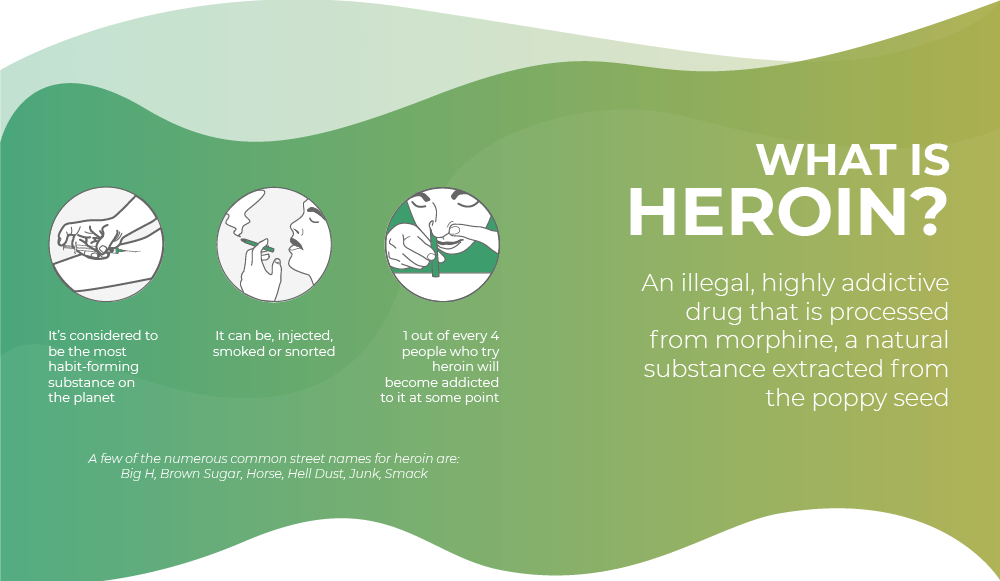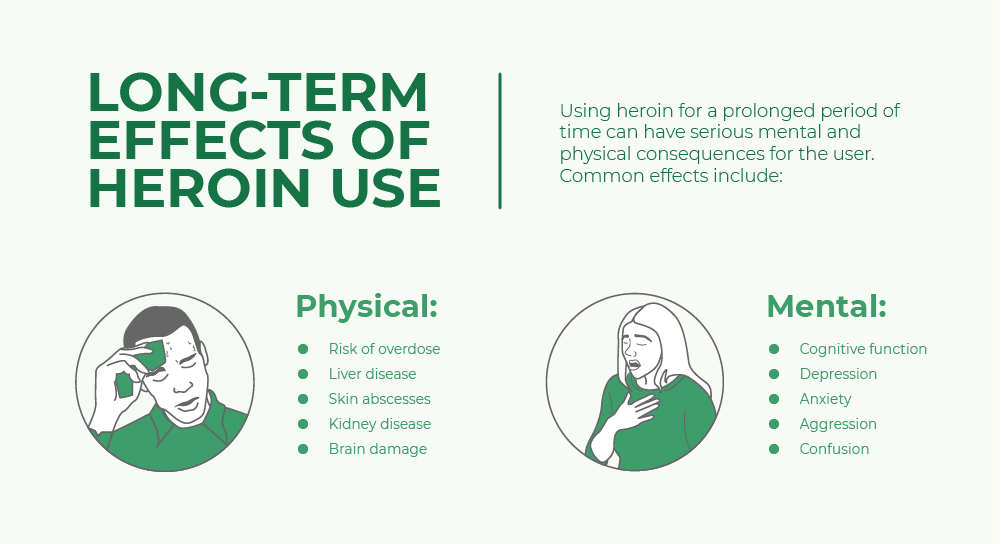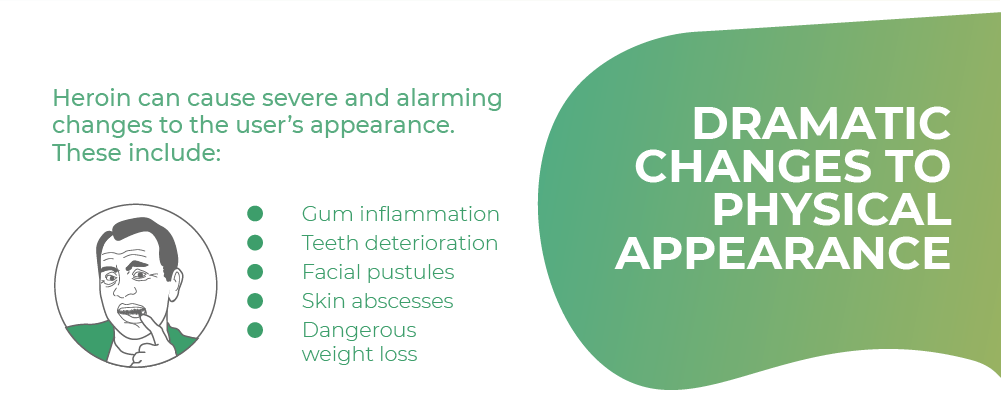Google Reviews
We’re a drug & alcohol treatment facility in Scottsdale, Arizona. Our blog provides news, information, and motivation to help individuals start or continue on their recovery journey from drug and alcohol addiction.
What is Heroin?
Heroin is an opiate drug made from the sap-like resin of the opium poppy plant, grown mainly in southern Asia and South America. Poppies are farmed to produced legal opioids for medical use, such as morphine, as well as illegal drugs like heroin.
The process of creating heroin involves opium being removed from the poppy flower’s pod and then refined into morphine. Morphine is then further refined to make heroin and other opiate-based drugs.
Like most opiates, heroin is highly addictive and can quickly become extremely destructive to both the bodies and lives of its users.
Heroin users inject, inhale, draw out or smoke the drug. Some users mix heroin with other substances, like crack cocaine, to get an increased effect. Mixing, called “speedballing” or “fastball,” increases the high, addiction rate and withdrawal.

It’s possible to recover from heroin addiction. We offer heroin addiction rehab.
Heroin’s affects on the heart rate, sleep, and breathing contribute to most opioid overdoses and deaths.
As a white or brown powder, or a sticky black substance, heroin is also known by the following common street names: Big H, Brown Sugar, Horse, Hell dust, Junk, Smack.

Heroin and The Body
Heroin is so addictive that drug users often ignore the damage being done to their bodies, faces, and even brains while chasing the next high. In this article, we’ll explore the destructive physical changes that affect heroin users over time. This article goes over the damaging changes that heroin use can cause to the body, face, and brain of a user.

A Brief History of Heroin
The Sumerians, known for inventing writing, were also the first to use opium around 3,300 B.C. Realizing the poppy plant’s strong “recreational” effects, they called it the “plant of joy,” and used it for both medicine and recreation.
Prescribing heroin for medical purposes as an opioid painkiller has created an opioid crisis in the United States.
In later years, opium was used around the world.
However, in 1853, the making of the hypodermic syringe increased heroin addiction. Middle to upper-class white women purchased the drug legally and became addicted at a rate nearly three times that of opiate addiction in the U.S. in the mid-1990s.
GET THE HELP YOU DESERVE!
Our treatment programs are custom tailored to your specific needs. One phone call is all it takes to start your recovery from drug & alcohol dependency.
CALL NOW | (855) 635-0050For a FREE & confidential assessment
The True Extent of the Current Opioid Crisis
Around 130 people still die every day from an opioid-related overdose in the U.S., according to the National Institute on Drug Abuse (NIDA). Still, the illegal making and importing of opioids worsen the problem. Sadly, the misuse and abuse of prescription opioid painkillers like OxyContin and heroin result in overdoses and deaths.
Data from the Centers for Disease Control and Prevention (CDC) found that the misuse of prescription opioids totals around $78.5 billion dollars a year. That’s a huge impact on the economy. Below are just a few startling statistics about the extent of the crisis:
- 21-29% of patients prescribed opioids for chronic pain will misuse them
- 8-12% will go on to develop an opioid use disorder (OUD)
- 4 – 6% who misuse such opioids will transition to heroin
- Predominantly, it is the young who are the most vulnerable from opioid addiction; however, every U.S. demographic is suffering
The Opioid Crisis & Heroin Addiction in Arizona
Just like every other state in the U.S., Arizona has had its share of the effects of the opioid epidemic plaguing the nation. According to theArizona Department of Health Services, statistics show that between June 15, 2017 and July 24, 2020:
- There have been about 6,500 suspected opioid deaths.
- There have been close to 47,000 suspected opioid overdoses.
Additionally, the NIDA reports that:
- In 2018, there were 1,106 opioid-overdose deaths reported in Arizona, out of a nationwide total of 14,996.
- 352 of those deaths were heroin overdoses.
Maricopa County, AZ, one of the worst affected counties in the state, reports that:
- Between October 2018 and September 2019, there were nearly 1,400 drug-related overdose deaths, mostly involving alcohol, opioids and/or methamphetamines.
- About 91% of overdose deaths in the county involved mixing drugs.
The Transition from Prescription Opioids to Heroin
Why are users of prescription opioid painkillers doing illegal heroin that they obtain from drug dealers on the street?
According to a review of U.S. survey data about opioid use between 2002 and 2012 by the NIDA, people who used opioid painkillers before were 19 times more likely to start using heroin.
Before entering treatment, 80% of abusers of opioids in the 1960’s used heroin.
However, in the 2000s, 75% of users reported that their first opioid was a prescription drug. Nationally, data on heroin users found that nearly 80% reported using prescription opioids before using heroin.
The factors below explain why users of prescription opioids are more likely to use heroin:
- Makers of prescription opioid painkillers (Big Pharma) do not tell the real story of opioid addiction.
- Even though prescription opioid painkillers are issued for use less than 3 months, people can still become addicted.
- Heroin is also cheaper and more readily available.
Heroin & The Brain
Using heroin greatly affects important areas of the human brain and users who overdose can suffer breathing failure. Both short and long-term use of heroin and other opioids can be dangerous and even fatal.
How Drug Users Achieve Their “High”: The Brain’s Opioid Receptors
Opioid receptors in the brain recognize and deal with pain, and medical professionals prescribe opioids to help with pain management. However, heroin use also affects the brain’s receptors. Additionally, opioids affect breathing, heart rate, and sleep cycles.
Although the brain actually produces its own opiates, using heroin or opioids interferes with the brain’s natural pain-relieving process. The interference causes the brain to need more opioids to achieve its natural level of pain reduction and increases dependency on heroin or other opioids.
How Does Heroin Affect the Brain?
Heroin abuse over time has been directly linked to major brain damage. In extreme cases, a user can suffer a total and fatal breakdown of their brain’s function.
Heroin inhalation raises the drug’s toxicity which has increased cases of brain damageand even dementia. As the brain needs more of the drug, tolerance and the chance of overdosing increase.
What Are The Short-Term Effects of Heroin?
As soon as the substance enters the user’s bloodstream, its dangerous effects happen quickly.
However, even before the “high” passes, the drug can cause deadly short-term effects. Some of the effects are as follows:
- Slowing of the respiratory function
- Nausea, vomiting, and loss of appetite
- Severe itching
- Runny nose
- Watery eyes
- Drowsiness
- Warm, flushed skin
- Loss of sex drive
- Risk of overdose
STRUGGLING WITH A DRUG PROBLEM?
Getting and staying sober is very challenging, but with the right support network and tools, it’s completely attainable.
For a FREE & confidential assessment
What Are The Long-Term Effects of Heroin?
The long-term effects of use can harm the body and brain and cause death. Additionally, the social and economic effects make heroin addiction hard to break.
Heroin use can cause deep depression and changes in behavior and physical appearance. Besides suicide attempts, below are some of the worst long-term effects:
Physical:
- Risk of overdose
- Liver disease
- Pulmonary infections
- Collapsed veins, leading to blood clots / stroke
- Kidney disease
- Brain damage
- Skin abscesses
- Arthritis
- Insomnia
- Heightened exposure to HIV, Hepatitis B, and Hepatitis C (through injection/needle sharing)

Mental:
- Cognitive function (caused by brain damage)
- Depression
- Anxiety/Panic attacks
- Aggression
- Confusion
Social / Economic:
- Destruction of the family unit
- Divorce
- Domestic violence
- Child abuse
- Financial / legal problems
A majority of the world’s poorest drug users (20%) abuse heroin, according to the United Nations Office on Drug and Crime.

How Does Heroin Change The Body?
Drug use can cause serious organ disease, collapsed veins, and brain damage. Heroin itself severely damages the user’s body and looks in some of the following ways:

Facial Spots, Skin Sores and Abscesses
White spots and red skin sores oozing with pus can appear on the faces and bodies of heroin users. Poor personal cleaning and hygiene bring on many other unattractive issues.

Skin abscesses are tender areas of pink and reddened skin like “boils.” These bumps often become infected.

It’s common for heroin users to scratch and rub their itchy and irritable skin and make infected areas worse.
Long-Term Effects & Body Changes Specific to Women
Although men are statistically more likely to abuse heroin, women experience different effects with the drug.
Female Heroin Users & Mental Health
The non-profit Caron Foundation’s study found that women were more likely than men to abuse drugs to self-medicate and suffered greater mental health disorders such as depression and anxiety.
In fact, the National Institutes of Health estimates that between 55-99% of all women in for a drug or alcohol addiction treatment have previously been sexually abused. In fact, female addicts, sexually abused as a child, are 3 times more likely than other women to develop an addiction.
Female addicts are also likely to come from dysfunctional families and engage in high-risk behavior to support their habit. These high-risk behaviors, like prostitution, put them at risk of violence, sexual assault, and sexually transmitted infections and diseases.
Female Heroin Users & Pregnancy
Using the drug during pregnancy can cause women to miscarry or suffer premature birth. It also puts children at risk of birth defects.
Neonatal Abstinence Syndrome
Female users can even suffer a common but severe medical condition known as neonatal abstinence syndrome (NAS). With NAS, heroin passes through the placenta to the fetus during pregnancy and causes the baby to become heroin-dependent. The condition affects both the fragile newborn and the mother.
Symptoms (a collection of actual withdrawal symptoms) of a child born with NAS include:
- Seizures
- Fever
- Irritability
- Tremors
- Slow weight gain
- Diarrhea and vomiting
- Excessive crying, and
- Possibly death
Lastly, female users who are pregnant should not be detoxified since that puts the fetus at risk (particularly in the first and third trimester). Instead, pregnant women should be treated with methadone, which will have fewer effects on the unborn baby.
Physical Effects of Heroin Withdrawal
Heroin is deemed to be one of the most addictive and strongest illegal drugs in circulation. Users can experience withdrawal symptoms within 6-12 hours after their last use. Withdrawal symptoms drive an addict to use again.
To withdraw safely from heroin use, medically-assisted detoxification with an accredited rehab center or a hospital is recommended. Going “cold turkey” or detoxing from heroin without such professional help can be extremely difficult alone. Heightened withdrawal symptoms usually result in a swift return to using the drug.
Heroin withdrawal symptoms, which peak around 2-3 days, can include:
- Nausea and vomiting
- Insomnia
- Agitation
- Diarrhea
- Dilated pupils
- Sweating
- Anxiety
- Abdominal cramping
- Muscle pain / aches, often severe
The length of withdrawal depends on several factors, which include:
- The total time period of use
- The quantity taken each time
- The frequency of use
- The method used, and
- Any underlying medical or mental health issues
Depending on the quantity an addict has regularly used over a length of time, recovering addicts are likely to suffer a medical condition known as post-acute withdrawal symptoms (PAWS). Symptoms for this condition, which can last 18-24 months, make abstinence difficult to maintain.
The symptoms of PAWS include:
- Increased anxiety and panic attacks
- Depression
- Fatigue
- Insomnia
- Hypersensitivity
- Irritability and restlessness
- Mood swings
- Memory loss
- Decreased levels of concentration
What Other Drugs are Often Mixed with Heroin?
Fentanyl,a prescription opioid medication used to treat severe pain, is commonly found in heroin. People may take it after surgery, cancer treatments, or when other types of pain medication do not work for them. However, Fentanyl that is used in hospital settings differs from the manufactured version illegally sold on the street.
Even the smallestmicrodose of Fentanyl added to heroin for more potency can be a deadly combination.
A high dose of Naloxone may be effective for treating an overdose on heroin laced with Fentanyl. But sadly this drug needs to be given soon after overdose, generally by a medical professional or first responder. If Naloxone and a person to administer it aren’t available to the person OD’ing, there’s a high risk of death.
How Quickly do People Form a Tolerance to Heroin?
According to the National Institute on Drug Abuse, this drug “produces profound degrees of tolerance and physical dependence”. This tolerance causes people to increase the amount of the drug they use or add additional drugs to chase the high they felt “the last time”.
The time it takes to develop tolerance is different for everyone. However, it generally takes a few days of consistent use to begin to develop tolerance. Tolerance is especially dangerous because it can also lead to withdrawal symptoms that are very difficult to manage without professional help.
What Does the Phrase, “Chasing the Dragon” Mean?
Anyone who has ever used heroin is probably familiar with the phrase, “chasing the dragon.” This refers to the first time a person experiences a heroin high. The incredibly euphoric feeling is “the dragon”.
But, no matter how hard users try to “chase” or experience that high again and again, they soon find out that it will never happen. Users can keep chasing for as long as they are abusing the substance. But that chase can end with their death.
Do People go Through Withdrawal Once Heroin is Stopped?
Yes, and it does not take long beforeheroin withdrawal symptoms begin. Some of the common symptoms of heroin withdrawal include:
- Feeling anxious
- Getting agitated and angry easily
- Muscle aches and pain in the body
- Increased eye tearing
- A runny nose
- Excessive sweating
- Excessive yawning
- Problems sleeping
- Stomach cramps
- Dilated pupils
- Goose bumps
- Nausea and vomiting
- Diarrhea
Symptoms can appear as soon as 12 hours after the last dose. They may persist for as long as two weeks, but there are some people who experience them longer.
Can the Changes From Heroin be Reversed?
It depends. Some of the physical effects from this drug can reverse themselves once the individual is in recovery, but others may be permanent. The same is true for the mental effects.
Everyone is unique and experiences recovery differently. People who have taken the drug for a much longer period of time may find that even though they stop using it, they have already done irreversible damage.
How Modern Recovery Can Help
Attempting addiction recovery without professional support can be difficult. At Modern Recovery, we understand that individuals seek and use drugs for different reasons. This is why we make it a point to treat each of our patients as individuals and create treatment plans that will help them on their road to recovery.
The detox process involves a medical team who will help you through the process of getting the drugs out of your system. Modern Recovery works directly with several detox facilities and will help you determine which one will work best for your particular needs.
If you or someone you love needs support, encouragement, or guidance getting clean and maintaining sobriety, we encourage you to contact us here at Modern Recovery. We offer a holistic approach that addresses many of the complex issues related to addiction and recovery.
GET IN TOUCH WITH US
SEND US A MESSAGE
Sources:
- National Institute on Drug Abuse: Opioid Crisis Article
- The Centers for Disease Control and Prevention
- Arizona Department of Health Services
- National Institute on Drug Abuse: Prescription Opiods Risk Factor
- JAMA Network
- UNDCP PDF
- National Institutes of Health Article
- National Institute on Drug Abuse: How Drug Abuse Affects Pregnant Women
- Substance Abuse and Mental Health Services Administration
- Substance Abuse and Mental Health Services Administration
- National Institute on Drug Abuse: Fentanyl
- Emergency Medicine News
- National Institute on Drug Abuse: Long-Term Effects of Heroin Use
- National Library of Medicine